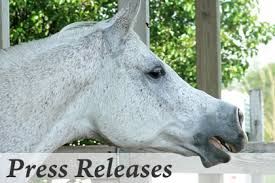Truett Takes the Reins of Savvy Feeder
- Posted by Press Release
Dr. Lenny and Jen Truett of Dancing Horse Farm, Lebanon, Ohio, are pleased to announce they have “taken the reins” of the established and successful company, Savvy Feeder, the preeminent option for slow feeding hay to horses safely in a natural, head-down position.
Jen, a successful dressage trainer and competitor, United States Dressage Federation FEI Certified Instructor and Diamond Achievement award winner, began researching available slow feeding options for her developing Grand Prix horse, “Dreamy”. Jen wanted to reduce the volume of hay lost in his water buckets, as well as boredom after meals. She started with small hole nets and bags, but Dreamy was so aggressive in his hay net flinging, that he made his neck quite sore. Jen discovered that Dreamy’s experience wasn’t isolated; there is quite a bit of research on the torque and stress on horses neck and back muscles caused by hung hay net/bag use.
Since horses are foragers, their digestive system is designed to eat from the ground, which keeps the GI tract healthy by actively processing small amounts of food over extended periods of time. Jen searched for a floor slow feeder that was heavy-duty enough to hold up to Dreamy’s shod feet, because he puts them in or on everything. She found several options available on the market, but most require wall attachment. Knowing Dreamy’s athleticism, Jen wanted a completely mobile feeder so he could freely move it around his stall and, when he did put feet in it, he could easily and safely take them back out.
Jen and engineer husband, Lenny, brainstormed design ideas to build their own hay feeder to fulfill her requirements for Dreamy. Then, a client told Jen about how impressed she was with her Savvy Feeder, and even let Dreamy test drive it. Dreamy was sold immediately! After getting the initial feeder, they went on to purchase enough feeders to put one in each of their boarding/training farm’s dry lot paddocks and in each of their personal horses’ stalls. Using the feeders on a larger scale around the farm brought to light the cost savings gained from virtually eliminating hay waste caused by being blown away, rained on, or made into a horse bed or toilet.
Jen is an avid believer that slow feeding hay using Savvy Feeder, is a smart investment in horse’s health and happiness and can help save money on vet bills! Ensuring horses have access to hay over extended periods of time helps reduce the risk of GI issues like ulcers, and stall vices like weaving, stall walking, pawing, kicking, etc. that are damaging to the horse’s body. Using a Savvy Feeder can also reduce the risk of sand colic and development of enteroliths because the feeder keeps the hay contained, and off of sandy soil.
Jen has sung her praises of Savvy Feeders since introducing them to her farm, so she and Lenny were honored when Julie Johnson, inventor and owner of Savvy Feeder, approached them about taking over her company. Julie’s dream for Savvy Feeder in the Truett’s care, is that Jen’s broad reach in the equine industry will introduce the product to an even wider audience throughout the US and eventually around the world. March 1, 2023, was the first day of business for Savvy Feeder operating out of the Truett’s Dancing Horse Farm, Inc. in Lebanon, Ohio. Jen and Lenny look forward to helping horses live happier, healthier lives while saving their humans money along the way!
More information, video tutorials, and customer testimonials can be found at www.SavvyFeeder.com.
Written by:
Press Release
Related Articles
Stay on top of the most recent Horse Health news with













